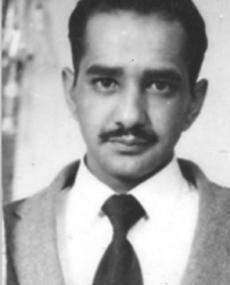
Suliman "Babla" Saloojee was born on 5 February 1931 in the small town of Belfast in the then eastern Transvaal, now Mpumalanga. Babla was compelled to leave home in order to gain a basic education. After completing his education he worked as worked as a legal clerk, but often presented himself as a qualified lawyer when his comrades were in trouble with the police. This enabled him to trace the whereabouts of detainees, obtain legal assistance and arrange for essential provisions to be delivered to them.
Babla joined the Transvaal Indian Congress (TIC) and the Transvaal Indian Youth Congress (TIYC) and became a well-known figure in its circles. During the 1950s, he was a member of the Picasso Club, along with Ahmed Kathrada, Mosie Moolla, Abdulhay Jassat and Farid Adam spending many nights painting political slogans and putting up posters. They named their group after Picasso, a famous European painter, as a ploy to come together to do political sloganeering work.
Babla also participated in the major anti apartheid campaigns such as the Defiance Campaign. He also assisted in smuggling a number of political activists out of the country. For instance he assisted his close friends Abdulhay Jassat and Mosie Moolla in successfully leaving the country after they escaped from detention despite a massive manhunt launched by the security police. Babla was detained on the night of his engagement to Rookie Adam in 1961. In February 1964 he was served with a banning order.
On 6 July 1964 Babla, along with Ahmed Essop “Quarter” Khota, was arrested and taken to Marshall Square. His wife, Rookie who he married on 1st July 1962, recalls that the last time she saw him he had a bandage on his head. When she tried to inquire as to what happened the visit was cut short. It is widely believed that on 9th September 1964 he was severely tortured, killed and thrown out of the seventh floor window (a height of 20m) from Gray’s Building, the Special Branch headquarters in Johannesburg .when this happen Babla was 28 years old,he was in detention for 65 days,At the inquest the magistrate found that no one was to blame for Mr Saloojee's death.Moreover,nothing in the evidence suggested that the methods used in interrogation had been irregular.
The inquest found that the cause of death was unknown, but to this day the suspicion lingers that he was murdered. The most emotive and heartfelt tribute to Babla was written by his close friend Ahmed Kathrada:
Suliman Saloojee, my dearest friend Babla, was dead, killed by the police. This most gentle of men, this inveterate prankster, my comrade and source of strength, had been picked up under the ninety-day detention law, brutally interrogated and tortured to death - by the sadistic Rooi Rus Swanepoel - then flung from a window on the seventh floor of Gray’s Building, Johannesburg headquarters of the security police, on Wednesday 9 September 1964.
Not surprisingly, the so-called inquest accepted the police version that Babla had committed suicide by jumping to his death.
I have never doubted, however, that he died under interrogation, and that his body was then thrown out of the window”¦ The magistrate found that ‘nothing in the evidence suggested that Saloojee had been assaulted or that methods of interrogating him were in any way irregular. He found that no one was to blame for his death. (Kathrada 2004: 207)